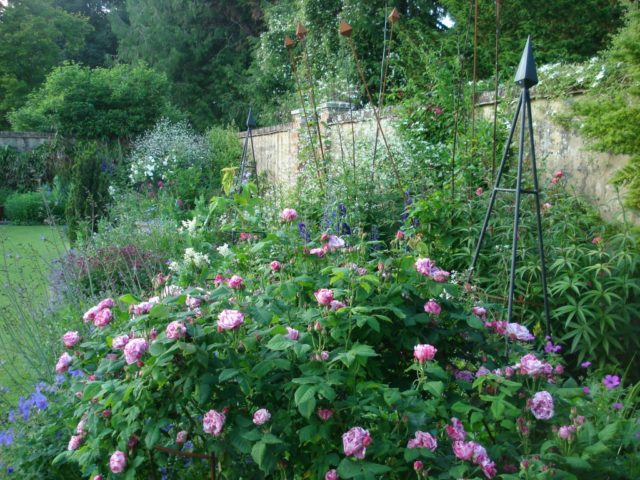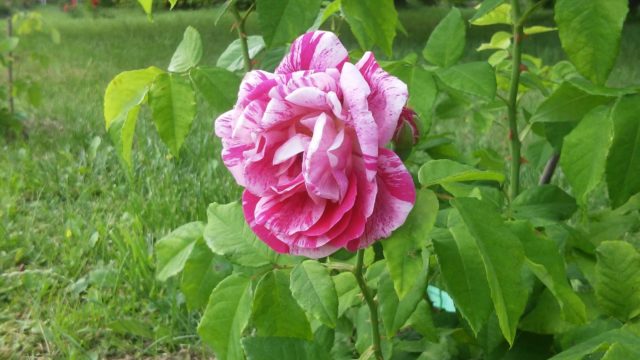Content
Park rose Ferdinand Pichard until recently was considered one of the best striped varieties. New hybrids that have appeared have slightly reduced consumer interest in this species, captivating with novelty. But until now, flower growers are happy to plant these beautiful, unpretentious flowers on their plots. Every amateur gardener should consider the history of the variety of park roses "Ferdinand Pichard", a description of its features, photos and reviews.
Breeding history
The history of Ferdinand Pichard rose is 100 years old. Bred in 1921 in France, it confidently retained its leading position in popularity among flower growers. He won prizes at international exhibitions and festivals in 1998-2001. The originator of the variety is Remy Tanne. He was working on a new kind of hybrid rose with a remontant, using, among other things, the Commandant Beaurepaire variety. Registered under the name Ferdinand Pichard. The park rose Ferdinand Pichard is not included in the Russian State Register.
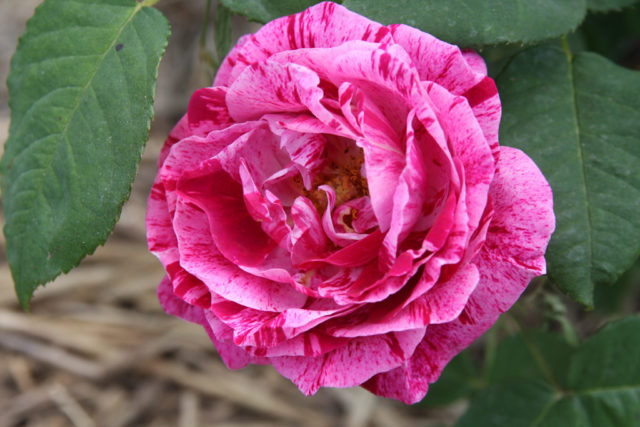
Only the new varieties bred in the 60-70s of the XX century based on the park rose Ferdinand Pichard forced this beauty to make room on the podium
Description of park rose Ferdinand Pichard and characteristics
Rose Ferdinand Pichard belongs to the Old Garden Roses according to the classification approved by the WFRS - World Federation of Gardening Societies in 1976. It is a hybrid of a remontant rose that blooms twice a season - in the first month of summer and in September. The height of the bush varies depending on the region of growth. In temperate and northern climates, they reach 0.9-1.4 m, and in the southern zones they can grow up to 2.3-2.8 m.The diameter of an adult bush is 1-1.4 m.
Numerous shoots are erect, directed vertically. Branched at the apex, almost thornless. Lacquer-smooth, changing as they grow in color from light emerald to grayish green and reddish brown. The leaves of the park rose Ferdinand Pichard are numerous, densely growing. Large or medium-sized, rich, bright green, glossy, without edging. Sometimes it can be light green or olive.
The first wave of flowering takes place in early summer. At the ends of the shoots, single buds appear, as well as 2-6 clustered in racemose inflorescences. Double flowers reach 5-12 cm in diameter. The number of petals is 25. Their shape is bowl-shaped, spherical. The upper part curves smoothly outward and downward. The color of the park rose Ferdinand Pichard is very interesting. On a rich bright red or carmine background, amethyst spots and stripes are scattered with uneven strokes, which in the sun begin to fade to a pinkish-white color. It is thanks to this unique feature that the following shades can be simultaneously present on the buds:
- deep burgundy and red;
- hot pink and crimson;
- pale pink, cream and snow white;
- scarlet, burgundy and ruby.
The aroma of flowers is intense, sweet honey, with light refreshing shades, very pleasant. The flowering bush looks decorative. Re-park rose bears fruit in early autumn, but not so abundantly. Experienced flower growers, using agricultural techniques and creating favorable conditions for the shrub, achieve gradual flowering throughout the season.
Park rose Ferdinand Pichard does not need shelter for the winter and is able to withstand frosts down to -35 degrees. It perfectly tolerates the peculiarities of the Russian continental climate. She is not afraid of sudden temperature changes from heat at +35 to rainy periods, when the thermometer drops to +10.
If the area where the flowering shrub grows is in the shade, then the shoots can be very stretched and thinned. In this case, a garter to a trellis, pergola or trellis is required. Without pruning, the park rose stretches upward, which is not always convenient. Therefore, gardeners in most cases shape the plant by pruning.
Park rose Ferdinand Pichard is highly resistant to a number of typical diseases:
- powdery mildew;
- black spot.
The rose needs an average humidity, in the region of 40-70%. Dry air increases the risk of pest infestation. And too high an indicator provokes the development of fungal and bacterial infections.
During heavy rains, the buds lose their color. As soon as the sun peeps out, the saturation of the shades returns rapidly and the aesthetic qualities of the variety are restored.
Ferdinand Pichard grows well in high, sunny areas, protected from drafts and winds. If the place is low, close to subsoil water or rainwater regularly accumulates, then the roots of the plant will rot. As a result, the landing is killed.
The park rose Ferdinand Pichard is a great decoration for any landscape. Its highest decorative properties and unpretentiousness have been tested by generations of garden flower lovers, and there is no doubt about it.
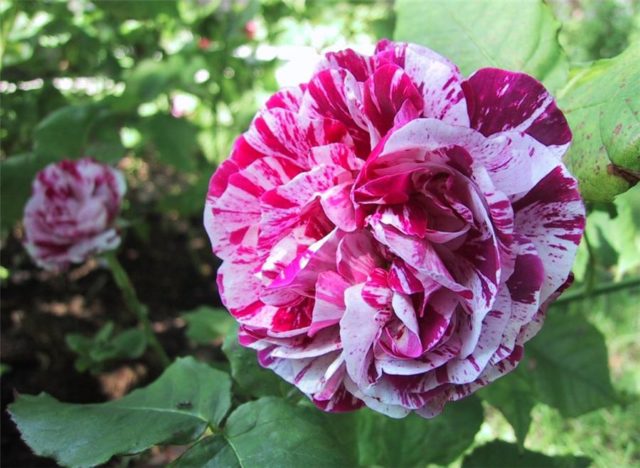
With the right choice of location and care, the park rose Ferdinand Pichard pleases with lush flowering throughout the summer
Advantages and disadvantages of the variety
Park and bush rose Ferdinand Pichard is a highly decorative variety that has a lot of advantages:
- strong, straight shoots, suitable for flower arrangements;
- neat, compact shrub, easily tolerant of formation;
- lack of thorns, large flowers with attractive, interesting colors;
- high resistance to frost and sudden temperature changes;
- endurance to adverse environmental conditions;
- resistance to fungal infections.
Among the disadvantages of a park rose, one can single out the shedding of buds in drought and poor tolerance of strong waterlogging of the leaves and root system.
Reproduction methods
Park rose Ferdinand Pichard can be propagated in several ways:
- Cuttings... For planting material, cut off the faded tops of shoots 20-35 cm long with three or more living buds. The cut must necessarily have a slope of 450. The cuttings are vertically buried into the nutrient substrate by 10 cm and covered with glass or plastic. For the winter they fall asleep with peat, needles, sawdust.
- Dtree bush... The mother plant is best split in early spring before budding begins. Part of the rhizome with live shoots is separated.
- Layers... Lateral flexible shoots of Ferdinand Pichard's park rose must be pressed to the prepared soil with a staple or wooden slingshot. Sprinkle with soil, put the upper part of the branch vertically, tie it up. Water for a month. As soon as the branch has taken root, it must be separated from the maternal shoot and transplanted.
Growing and care
Climbing park rose Ferdinand Pichard is demanding on the composition and quality of the soil. Prefers fertile, loose soils with a slightly acidic reaction, air and moisture permeable.
It is worth considering the following requirements:
- Prepare holes in advance, 2-3 weeks before planting, at a distance of 0.8-1 m from each other.
- Lay a layer of drainage at the bottom, add humus, peat, fertile sod land to the soil. If the soil is too heavy, coarse clean sand is needed.
- Add humus and one glass of wood ash.
Watering is carried out once a week, an adult bush requires 1.5-2 buckets of settled water. They begin to feed the plants in the second year of life. In the spring, sanitary pruning should be carried out, and two-year-old shoots should be shortened by 2-5 buds.
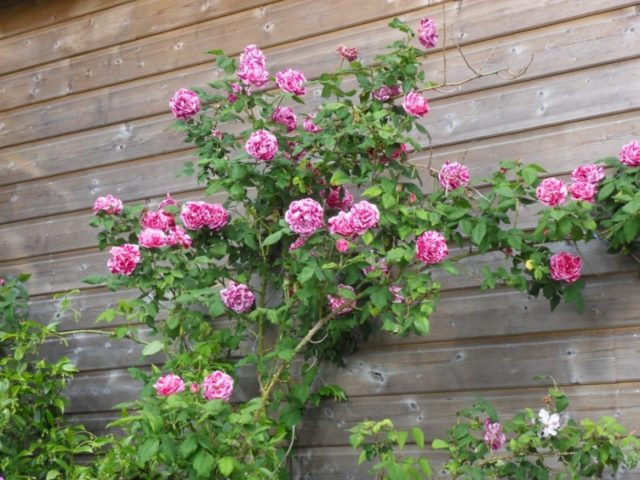
Park rose Ferdinand Pichard is responsive to proper care
Pests and diseases
The park rose Ferdinand Pichard is resistant to most diseases and is rarely attacked by insects. With too much watering or in a rainy summer, a fungal infection may develop. In this case, the affected branches are cut out and treated with a suitable fungicide.
Of the pests, aphids, scale insects and spider mites are dangerous. If insects are found, it is urgent to carry out treatment with folk remedies or an appropriate insecticide. For example, abundant spraying with a solution of laundry soap helps well against aphids.
Application in landscape design
In landscape design, the park rose Ferdinand Pichard is used to create single expressive compositions against the background of the lawn, as well as in living fences. They perfectly emphasize the comfort of the recreation area on the site, next to benches, swings or artificial reservoirs.
They can be planted in flower beds, in the center, or as a bright backdrop for low-growing flowers. Ferdinand Pichard goes well with greens, blues, pastel white and blue tones. These roses make magnificent flowering labyrinth walls.
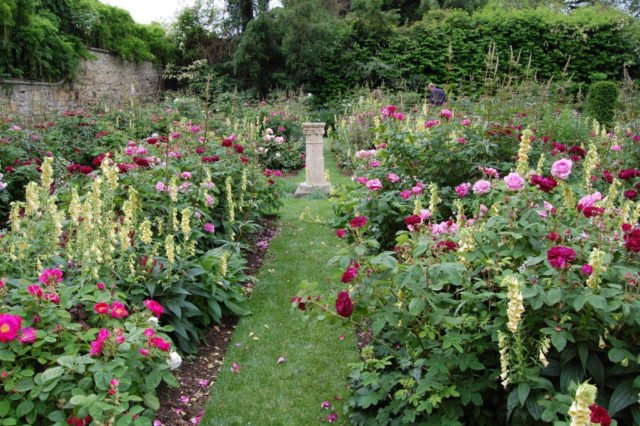
The rose bushes Ferdinand Pichard, framing the green carpet, creates a charming composition
Conclusion
Park rose Ferdinand Pichard is an old variety and has outstanding characteristics. For decades, the cultivar held the lead among the remontant striped varieties of roses. He is hardy, he feels great in any climatic zones of the Russian Federation. It responds to proper care with vigorous flowering during the warm season. The park rose is very decorative, and it is readily used to decorate personal plots.
